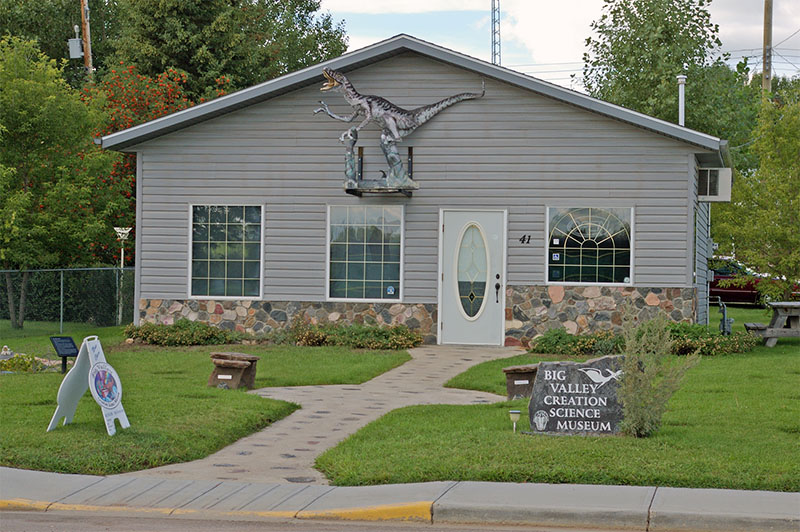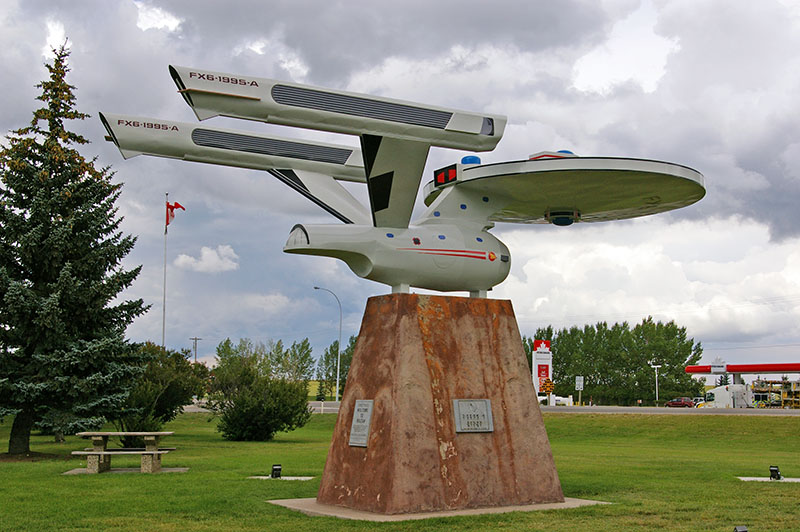
Description: Small post-agricultural or post-industrial towns struggle to maintain a viable population and identity in the face of decline and outward migration. Sometimes administrators and activists work to rebrand their towns, often by celebrating the past in a nostalgic fashion. Nostalgia is based on a sense of longing for an idealized past that never really existed. In that sense, The Torrington Gopher Hole Museum, discussed in the Unique category, participates in this kind of nostalgic rebranding with its dioramas about rural life. Yet the primary example of this kind of historical recreation is Nanton, located along a busy highway corridor south of Calgary. The town of Vulcan offers a counter example, for it does not invent and attempt to materialize a lost past, but has instead leveraged its association with the Star Trek franchise to increase tourism and business opportunities.


Feature Museum:
Big Valley

Click the image to see more photos of Big Valley
The aptly named Big Valley is a small town of under 400 residents that has experienced its share of booms and busts, as various industries have peaked through the decades. Ranching, rail transport, coal and finally oil have now been supplanted by tourism. Best known as the terminus of the Stettler-based Alberta Prairie Railway Excursion, Big Valley is home to its own historic railway station and museums. Most attractions are heritage-themed, such as the Big Valley Museum housed in McAlister’s Garage, the Canadian railway Hall of Fame, and the ruins of the local roundhouse, all well-marked with weather-proof text panels. There are also a number of historic buildings around town, not the least of which is the 1912 CNR Depot. A newer addition to the town is the Big Valley Creation Science Museum, which opened in 2008. Likely intended to take advantage of the town’s established summer tourist influx, this small ideological museum positions itself against the dinosaur museums that dominate the museum world in Alberta, in particular the Royal Tyrell Museum of Palaeontology and the new Philip J. Currie Dinosaur Museum. Drawing on established methods of didactic exhibition design to legitimate its views, it promotes an anti-science narrative using real fossils as evidence. While its claims are highly suspect, the Big Valley Creation Science Museum nevertheless reveals and contests the fact that mainstream science museums present a particular world view. As such a dialogue can potentially be fostered between scientific scepticism and religious faith, although this occasionally degrades into hate mail.
Most significant is the town’s response to the presence of this new attraction. Although the potential for controversy is striking, the Creation Science Museum is simply treated as one of several attractions, and is actively cross-promoted. Inclusion, and trusting visitors to make their own judgements without prompting, has proven to be a good strategy, and visitors who come for one kind of entertainment will inevitably stay to experience the other as well.


Other Museum Towns:
Nanton
This larger town has a population of over 2000, and sits along a busy corridor connecting Calgary with Lethbridge and other communities to the south. As such it benefits from much business and personal traffic, as well as being a tourist destination in its own right. There are three museums: the Bomber Command Museum of Canada with its high-profile location and prize Lancaster bomber; the Museum of Miniatures, a privately-owned collection; and the Canadian Grain Elevator Discovery Centre. The town also has a number of antique shops, galleries, and bistros, and a restored Main Street. The highway’s northbound and southbound lanes are separated by a block and the speed limit is lowered well in advance, creating a comfortable walking environment. Bomber Command is typical for an aviation museum, housed in a large hangar with many historical aircraft and equipment on display. Some of these are still undergoing restoration by volunteers, and the site has been used for several war films. Authentic gun turrets have been built up with replica aircraft parts to create suitable sets. Expansion plans call for a second hangar of equal size.
The Museum of Miniatures is arguably not a museum at all, for it features miniature figures that are purchased and assembled (often in ingenious ways) in a commercial setting. This museum is in fact run as a business by Carol and Roy Wittman, who moved to Nanton from Cardston a few years ago. All the same, it draws on museum features for legitimation, including glass cases and labels inserted beside displays to explain them. Some of the scenes inside the museum refer to other, better known heritage sites in the region, including Head-Smashed-In Buffalo Jump, a UNESCO World Heritage site located 90 km away which is recognized for its continuous archaeological record spanning 6,000 years. The Museum of Miniatures creates a unique sense of place in relation to a network of other museums in Alberta, a strategy also used by larger, more traditional organizations.
Finally, the Grain Elevator Discovery Centre has undertaken some innovative approaches to exhibits in its two restored elevators, chiefly by cutting into some of the storage bins to create additional display space. The wood crib construction of these historic elevators is quite strong, and with the addition of flat floors and lighting, the bins provide ready-made rooms. Displays cover agricultural history and local heritage, and local artists have also been given space.
Vulcan

Click the image to see more photos of Vulcan
The town of Vulcan is known worldwide as the Star Trek town, a place famous for its folksy starship monument and for the happy coincidence by which the town shares its name with Mister Spock’s fictional homeworld. Once a significant agricultural centre, Vulcan experienced an all too common economic decline since the 1970s, as its twelve grain elevators were closed one by one. This decline was mitigated somewhat by the consequent growth of Star Trek fandom during the 80s and 90s, which drew attention, and tourists, to the town. An annual science fiction convention was established in Vulcan in 1993. Two years later the starship monument was erected, and in 1998 the distinctive Trek Station opened, a combined tourist bureau and memorabilia store styled after a flying saucer. In 2009 the town of Vulcan undertook a significant rebranding through a unique licencing partnership with CBS, which currently owns the television rights to the Star Trek franchise. This partnership allows the town to use the Star Trek fonts, name, and associated trademarks for a fee – and they appear everywhere, from street signs to murals to exclusive licenced products. Finally, in 2013 a privately-owned museum, Trekcetera, opened its doors. While Trekcetera better fulfils visitor expectations of seeing significant artifacts from Star Trek, Trek Station is more closely linked to the rebranding of the town, drawing many links between the science fiction franchise and Vulcan’s agricultural past, in particular the pioneering spirit of frontier settlement that forms the basis of heritage museum narratives. Meanwhile, the annual convention has continued to draw increasingly large crowds every year, and was renamed Vul-Con in 2015. Today Star Trek imagery pervades the town, which has become a site of pilgrimage for several generations of fans. However, many residents have been unwilling to embrace the Trek-themed vision of the town’s future, as they either do not understand the magnitude of the franchise and its potential to generate wealth, or because they feel a cultural disconnect with the values espoused by science fiction and long for a return to “simpler times.” Despite this resistance Vulcan has introduced a variety of measures to attract new business and new residents: among them a solar park, fibre-optic internet, and a new senior’s centre. As a result the town is experiencing a kind of identity crisis, as it decides what kind of future it wants.

 Aboriginal and Metis Museumstop of page
Aboriginal and Metis Museumstop of page









 Aboriginal and Metis Museumstop of page
Aboriginal and Metis Museumstop of page